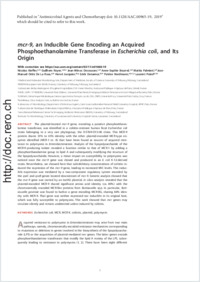mcr-9, An inducible gene encoding an acquired phosphoethanolamine transferase in Escherichia coli, and its origin
- Kieffer, Nicolas Medical and Molecular Microbiology Unit, Department of Medicine, Faculty of Science, University of Fribourg, Switzerland
- Royer, Guilhem Laboratoire de Bactériologie et d’Hygiène-Hospitalière, CHU Henri Mondor, Assistance Publique–Hôpitaux de Paris, Créteil, France - IAME, UMR1137 INSERM, Université Paris Diderot, Université Paris Nord, Emerging Antibiotic Resistance in Gram-Negative Bacteria, Paris, France - LABGeM, Génomique Métabolique, Genoscope, Institut François Jacob, CEA, CNRS, Université Evry, Université Paris-Saclay, Evry, France
- Decousser, Jean-Winoc Laboratoire de Bactériologie et d’Hygiène-Hospitalière, CHU Henri Mondor, Assistance Publique–Hôpitaux de Paris, Créteil, France - IAME, UMR1137 INSERM, Université Paris Diderot, Université Paris Nord, Emerging Antibiotic Resistance in Gram-Negative Bacteria, Paris, France
- Bourrel, Anne-Sophie Laboratoire de Bactériologie et d’Hygiène-Hospitalière, CHU Henri Mondor, Assistance Publique–Hôpitaux de Paris, Créteil, France - IAME, UMR1137 INSERM, Université Paris Diderot, Université Paris Nord, Emerging Antibiotic Resistance in Gram-Negative Bacteria, Paris, France
- Palmieri, Mattia Medical and Molecular Microbiology Unit, Department of Medicine, Faculty of Science, University of Fribourg, Switzerland - bioMérieux, Data Analytics Unit, La Balme Les Grottes, France
- Ortiz de la Rosa, José Manuel Medical and Molecular Microbiology Unit, Department of Medicine, Faculty of Science, University of Fribourg, Switzerland - INSERM European Unit (IAME, France), University of Fribourg, Switzerland
- Jacquier, Hervé IAME, UMR1137 INSERM, Université Paris Diderot, Université Paris Nord, Emerging Antibiotic Resistance in Gram-Negative Bacteria, Paris, France - Laboratory of Microbiology, Department of Infectious Agents, Saint Louis-Lariboisière-Fernand Widal University Hospital, APHP, Paris, France
- Denamur, Erick IAME, UMR1137 INSERM, Université Paris Diderot, Université Paris Nord, Emerging Antibiotic Resistance in Gram-Negative Bacteria, Paris, France - Laboratoire de Génétique Moléculaire, Hôpital Bichat, Assistance Publique–Hôpitaux de Paris, France
- Nordmann, Patrice Medical and Molecular Microbiology Unit, Department of Medicine, Faculty of Science, University of Fribourg, Switzerland - INSERM European Unit (IAME, France), University of Fribourg, Switzerland - Swiss National Reference Center for Emerging Antibiotic Resistance (NARA), University of Fribourg, Switzerland - Institute for Microbiology, University of Lausanne and University Hospital Centre, Lausanne, Switzerland
- Poirel, Laurent Medical and Molecular Microbiology Unit, Department of Medicine, Faculty of Science, University of Fribourg, Switzerland - INSERM European Unit (IAME, France), University of Fribourg, Switzerland - Swiss National Reference Center for Emerging Antibiotic Resistance (NARA), University of Fribourg, Switzerland
-
01.09.2019
Published in:
- Antimicrobial Agents and Chemotherapy. - 2019, vol. 63, no. 9, p. 10.1128/aac.00965-19
English
The plasmid-located mcr-9 gene, encoding a putative phosphoethanolamine transferase, was identified in a colistin-resistant human fecal Escherichia coli strain belonging to a very rare phylogroup, the D-ST69-O15:H6 clone. This MCR-9 protein shares 33% to 65% identity with the other plasmid-encoded MCR-type enzymes identified (MCR-1 to -8) that have been found as sources of acquired resistance to polymyxins in Enterobacteriaceae. Analysis of the lipopolysaccharide of the MCR-9- producing isolate revealed a function similar to that of MCR-1 by adding a phosphoethanolamine group to lipid A and subsequently modifying the structure of the lipopolysaccharide. However, a minor impact on susceptibility to polymyxins was noticed once the mcr-9 gene was cloned and produced in an E. coli K-12-derived strain. Nevertheless, we showed here that subinhibitory concentrations of colistin induced the expression of the mcr-9 gene, leading to increased MIC levels. This inducible expression was mediated by a two-component regulatory system encoded by the qseC and qseB genes located downstream of mcr-9. Genetic analysis showed that the mcr-9 gene was carried by an IncHI2 plasmid. In silico analysis revealed that the plasmid-encoded MCR-9 shared significant amino acid identity (ca. 80%) with the chromosomally encoded MCR-like proteins from Buttiauxella spp. In particular, Buttiauxella gaviniae was found to harbor a gene encoding MCR-BG, sharing 84% identity with MCR-9. That gene was neither expressed nor inducible in its original host, which was fully susceptible to polymyxins. This work showed that mcr genes may circulate silently and remain undetected unless induced by colistin.
- Faculty
- Faculté des sciences et de médecine
- Department
- Médecine 3ème année
- Language
-
- English
- Classification
- Biological sciences
- License
- License undefined
- Identifiers
-
- RERO DOC 327449
- DOI 10.1128/AAC.00965-19
- Persistent URL
- https://folia.unifr.ch/unifr/documents/308225
Statistics
Document views: 121
File downloads:
- nor_mig.pdf: 222
